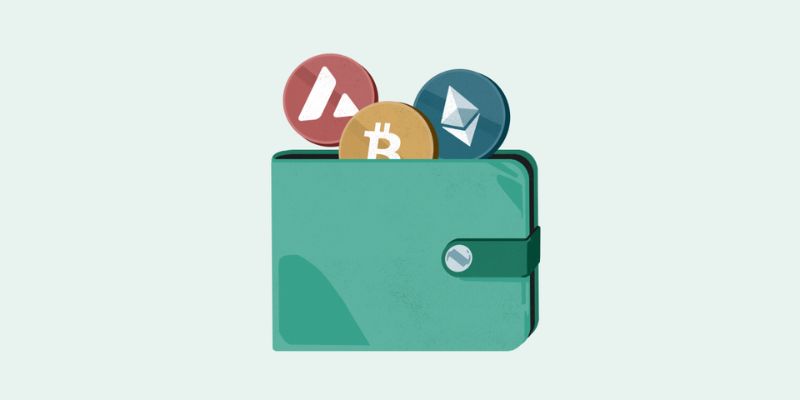Thinking about how to create a crypto wallet? If you want to join the digital gold rush, you’ll need a secure spot to stash your hard-mined coins. It’s not as tough as it sounds—I’ll walk you through picking a wallet that fits like a glove and keeps your digital bucks safe. Let’s start with the basics, from hot to cold, and make sure you can tell which wallet works best for your crypto life. After that, I’ll guide you step by step to lock it down tight. You’ll be a pro at managing your digital fortune, paying the smart way, and beefing up your wallet’s guard. Ready to build your financial fortress? Let’s dive in!
Choosing the Right Type of Crypto Wallet for Your Needs
Understanding Different Types of Crypto Wallets
When you start looking for a wallet to store your digital assets, you’ll see there are many kinds. Software wallets, hardware wallets, and mobile apps are the main types you’ll run into. A software wallet is like an app on your computer or phone. It’s easy to use and lets you access your crypto fast. A hardware wallet is a physical device that connects to your computer. It’s like a USB stick but for crypto, super secure because it keeps your coins offline. Mobile wallet apps are great for paying on the go. You can use your phone to send or get crypto quick.
Each type of wallet has its own setup steps and security features. Software wallets are often free and simple to install. Hardware wallets can cost some money but are worth it for the security. Mobile wallets are also free and work on your phone, good for everyday use.
Comparing Hot Wallets vs. Cold Storage Solutions
Now let’s dig into hot and cold wallets. These terms may seem odd at first. Hot wallets are connected to the internet. Cold wallets are not. Keeping your coins in a hot wallet is like keeping cash in your pocket. It’s handy, but you might lose it if you’re not careful. Cold wallets keep your coins safe like money in a bank vault. They are offline, which means they’re harder for bad folks to get to.
Hot wallets include online services, software on your computer, or mobile apps. They’re great for daily use but need good internet safety habits. Cold wallets include hardware wallets and paper wallets. They take more steps to set up, but once you do, they’re the safest home for your coins.
It’s not just about hot or cold, though. You also need to protect your private keys and know how to back up your wallet. Your private key is a secret code that lets you access your coins. It’s like the key to a treasure chest. If someone else gets it, they can take all your coins. Make sure you keep this key safe and always have a backup plan!
Choosing the right wallet means thinking about how you use your crypto. Do you buy things with it often? Maybe you need a mobile wallet. Are you saving your crypto for a long time? A hardware wallet might be better. No matter your choice, make sure you understand how to keep it secure.
When you set up your wallet, you’ll learn about wallet encryption and backup protocols. It sounds hard but really just means keeping your wallet locked up tight with a secret code and having a copy in case something goes wrong. Want to keep your digital treasure safe? Start by picking the right wallet for you. I promise, it’s worth the effort to protect your digital fortune!
Setting Up Your Crypto Wallet Step by Step
Securely Installing and Encrypting Your Wallet
First up, let’s get your wallet installed. For a software wallet, visit the provider’s website. Download the official wallet app. Be wary of fake apps. They can steal your coins. Make sure to get the real deal!
Choosing a wallet type is like picking shoes. What fits your daily needs? A software wallet is handy, on your phone or computer. A hardware wallet is extra safe, like a secure vault. Then there’s the paper wallet, simple, offline storage.
When you install your wallet, you must create a strong, unique password. Think of it as the key to your digital treasure chest. This step is critical. A weak password can mean stolen coins.
Next, you’ll encrypt your wallet. Think of encryption as a protective bubble. It keeps your coins safe from hackers. Always use an encrypted password that’s tough to guess. Your future self will thank you.
Backing Up Your Wallet and Protecting Your Private Keys
Now, let’s talk backups. Picture this: your computer crashes, your phone takes a swim. Without a backup, you could lose your cryptocurrency. Scary, right? So, set up a backup. Do it right away. Store it somewhere safe, like an encrypted USB drive or a secure cloud service.
Your private keys are the heart of your wallet. They’re like secret codes that unlock your coins. Never share them. If someone gets them, they get your coins. Write down your private keys or seed phrase. A seed phrase is a bunch of random words that act like a master key.
Storing your seed phrase is serious business. It’s like hiding a treasure map. Some folks store it in a safe deposit box. Others, in a home safe. The point is, keep it hidden. Keep it safe from fire, water, and prying eyes.
If you play your cards right, managing multiple cryptocurrencies is a breeze. Wallets like Ledger or Trezor let you store different types of coins. It’s one place for everything. But check if your wallet supports all your coins. Not all wallets hold every type of coin.
Setting up a wallet takes work, yes. But the peace of mind? Worth it. Remember, your crypto’s safety starts with you. Take these steps seriously, and rest easy. Your digital fortune is secure.
Remember, keep your software updated, always. Like a phone or a computer, updates fix security holes. They keep your wallet working smooth. Follow these tips, and stay ahead in the crypto game.
Managing Your Digital Assets Effectively
Adding Multiple Cryptocurrencies and Understanding Addresses
Creating a digital wallet is like crafting your money’s digital home. You will want to pick the right one. Some wallets hold many types of coins. That way, you can manage all your digital money in one place. You’ll hear a term: “public address.” It’s like an email address for your wallet. When someone wants to send you crypto, you share this with them.
Let’s get it straight: your public address is for sharing. But keep your private address, or “key,” a secret. You need it to get into your wallet. Think of your public address like your home’s mailbox. Anyone can drop mail in, but only you have the key to open it. And every coin has a unique address. So make sure you use the right one for each coin.
Configuring Wallet Settings for Optimal Transaction Fees
In crypto land, we talk a lot about fees. You pay fees to move your money in the network. It can get tricky. But setting up your wallet right helps you not pay too much. Wallets can guide you on what to pay. But you can also pick your own fee. Low fee equals slow transfer. High fee? Faster transfer.
Here’s the deal: blockchains get busy. When they do, fees can rise. Pick a time when it’s not so busy, and you can save cash. And remember, every coin has its own fee. You can find out about fees in your wallet settings.
Some wallets let you set up something cool. It’s called “multisig.” It means you need more than one key to open your wallet. It’s like needing two keys to open a safe. This keeps your coins real safe. Always check your wallet can do this before you pick one.
Remember, a wallet doesn’t just hold your money. It also needs to talk to the blockchain. How does it do this? Through a “wallet synchronization process.” We won’t get too techy on you. But know this: your wallet checks facts with the blockchain. This must happen so it can show you your correct balance. It can take a bit, especially if your wallet is new. So give it time.
There you have it. You now know the basics of managing a wallet. Think of it as your pocket for digital coins. You can do this. Ready to store your crypto safe and sound? Let’s go!
Advanced Security Measures for Crypto Wallets
Implementing Two-factor Authentication and Multisig Wallets
If you’re setting up a digital wallet, security is key. Two-factor authentication (2FA) adds a layer of safety. It requires two types of proof from you before you can access your accounts. This could be a code from an app on your phone after you’ve used your password. Or, it might be a fingerprint scan along with a PIN code. This stops hackers, even if they have your password.
For higher protection, consider a multisignature wallet, or ‘multisig’. This wallet uses more than one key to approve a transaction. Think of it like needing several keys to open a bank vault. You need multiple approvals for each spending from your wallet. This is perfect for businesses or groups where you want shared control over funds.
Two-factor authentication and multisig make it much harder for thieves. They work like your own digital security team keeping your crypto wealth safe and sound.
Regularly Updating Software and Reviewing Wallet Compatibility
One of the best moves in blockchain wallet security is keeping software up to date. Wallet providers often release updates. These can fix security flaws or add new features. Think of it as a health check-up for your wallet; you don’t want to miss it.
It’s also smart to review wallet compatibility often. With tech always changing, you want to make sure your wallet works well with all the coins you manage. This means checking if new cryptocurrencies you’re interested in are supported by your wallet. It avoids the stress of needing a new wallet suddenly.
Never forget, the world of cryptocurrency is always moving. Staying updated is staying protected. Plus, reviewing compatibility can often teach you new tricks or better ways to manage your digital fortune.
Look after your crypto wallet like it’s treasure – because it is. Get 2FA and multisig set up. Keep your software fresh and check that all your coins fit snug in their digital home. Then, you can rest easy knowing your digital fortune is locked down tight.
To sum up, picking the right crypto wallet matters. We explored hot and cold wallets, learned to set them up with care, and manage our digital money smartly. Then we covered how to lock down our wallets tight for peace of mind. Think on what you need your wallet to do, and how much security you want. It’s your cash, so stay sharp, and always keep learning. Stay safe and make smart choices!
Q&A :
What are the first steps to creating a cryptocurrency wallet?
When you’re looking to get started with a cryptocurrency wallet, the first thing you want to consider is the type of wallet you need—software (mobile or desktop), hardware, or paper. Then, research and select a reputable wallet provider or wallet software. Finally, download and install the wallet, or purchase the hardware wallet, and follow the setup instructions provided, which typically involve creating a strong password and backing up your private key or recovery phrase.
How do you choose the right crypto wallet for your needs?
In choosing the right crypto wallet, consider the primary purpose of your wallet—are you looking for convenience, enhanced security, or both? If you plan to trade frequently, a software wallet could be more convenient. For long-term investment or larger sums, a hardware wallet offers increased security. Also, take into account compatibility with various cryptocurrencies, user interface, and backup features. It’s crucial to pick a wallet from a trustworthy provider with strong security measures.
What security measures should be taken when creating a crypto wallet?
When creating a crypto wallet, always use a complex and unique password, enable two-factor authentication (2FA) if available, regularly backup your wallet, especially the private key or seed phrase which is your recovery tool in case of access loss. Be wary of phishing websites and never disclose your private keys or seed phrase to anyone. Also, consider using a hardware wallet for an extra layer of security against online threats.
Can you create a crypto wallet for free?
Yes, you can create a software crypto wallet for free. There are many reputable wallet providers that offer mobile and desktop wallet applications at no cost. These wallets give you full control of your keys without needing to purchase a physical hardware wallet. However, while the wallet itself is free, remember that transactions will typically incur network fees depending on the blockchain you use.
What’s the difference between a hot wallet and a cold wallet?
A hot wallet is a cryptocurrency wallet that is connected to the internet. They’re generally easier to set up and use, and they’re convenient for traders and those transacting frequently. However, they are more vulnerable to online attacks. Cold wallets, on the other hand, are offline wallets such as hardware wallets or paper wallets. They provide increased security from online hacking risks but are less convenient for quickly accessing your assets for regular transactions.





